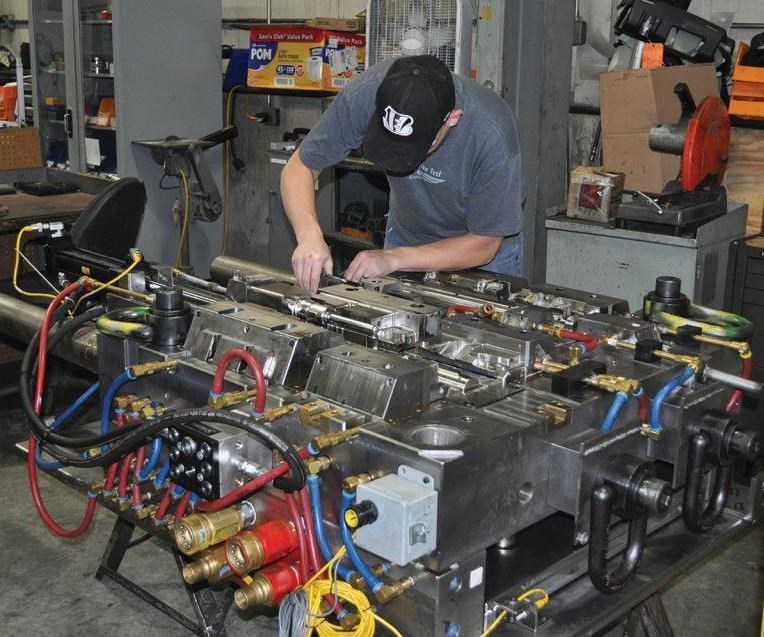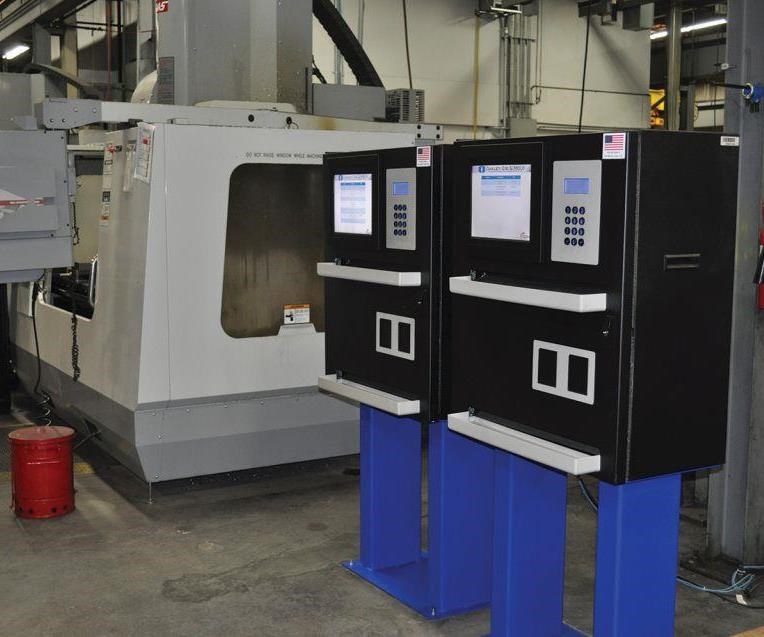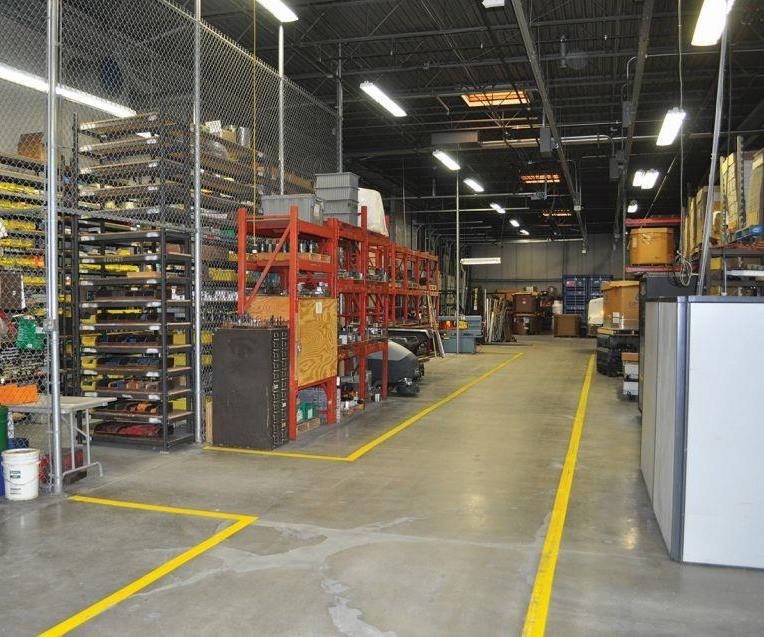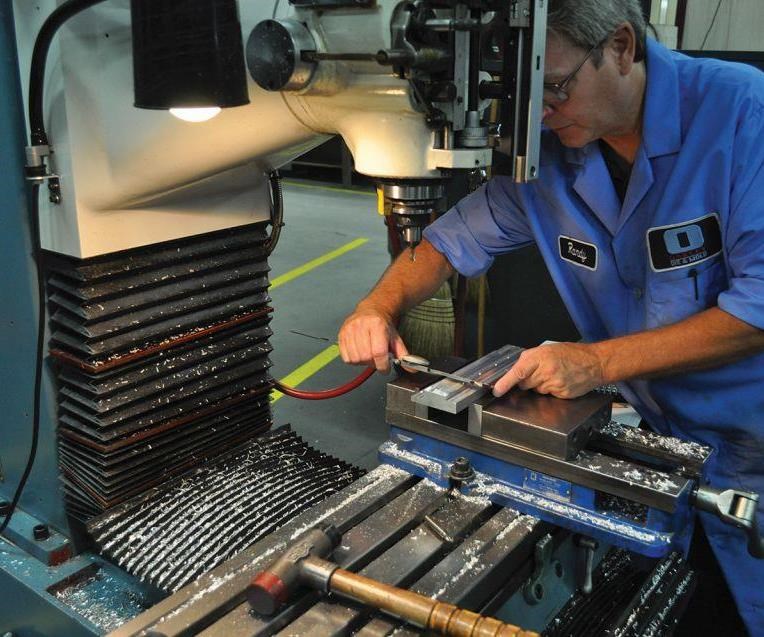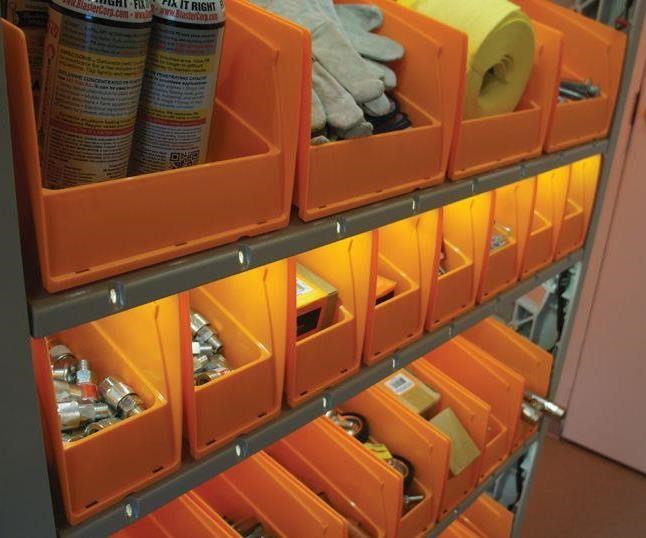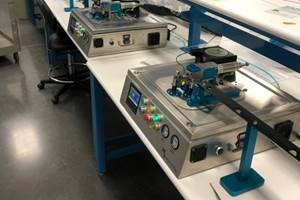Inventory Systems Boost Lean Manufacturing Efforts
Computerized, point-of-use storage and dispensing systems help this shop target waste that is difficult to measure and often labor-intensive to eliminate.
Share




Compared to just a few years ago, Oakley Die & Mold is a very different place.
The shelves and bins that once stretched nearly the entire length of the 50,000-square-foot shop floor are now sequestered in an area that’s less than half the previous size. There’s new machining equipment on the floor, and old workhorses have found new homes. There’s plenty of room to move around, too. In fact, the new layout has reduced the time traveled by a typical machined component through the shop from about 4 miles to less than 2.
So says Jim Goddard, who’s overseen the formal implementation of lean manufacturing practices since the Mason, Ohio, shop joined what’s now known as the Velocity Group in 2013. Although the change has been sweeping, he insists that the real key to sustainable lean transformation is attention to the little things—and when it comes to managing inventory, he means that literally. “If you can’t ship a $50,000 mold because you don’t have a 20-cent bolt, that 20-cent bolt becomes critical,” he says.
By the time this article is published, all of the bolts and nuts in the ever-diminishing toolroom will have been cleared away, Mr. Goddard says. So will most of the ejector pins, slides, lifters and other plastic injection mold components that constitute the lion’s share of what’s left, thus shrinking the area by yet another 50 percent. Rather than sitting on what once seemed like miles of shelves gathering dust, this inventory will have joined the cutting tools and shopfloor measuring instruments already sequestered away in computerized, point-of-use storage and dispensing units.
Inventory management is anything but an accounting function here, he explains about Oakley’s broadening embrace of these systems. In fact, the shop’s experience shows that practices surrounding the purchasing, storage and retrieval of items used in day-to-day production can be rife with waste—the type of waste that, if it’s recognized at all, shows up on the balance sheet only in the form of the human labor required to address it. From the very outset of Oakley’s transformation, strategically placed “smart” lockers and vending systems have provided a relatively easy, fast means of both finding this waste and eliminating it, all by virtue of designs that embody some of the very same principles driving broader change at the 40-employee shop. In this way, they served as early testaments to the power and legitimacy of lean thinking. “This technology was a no-brainer for us,” Mr. Goddard says.
5S in a Box
The choice of supplier certainly wasn’t difficult. The Velocity Group, which consists of Oakley and two other Ohio manufacturing facilities, was initially brought together in mid-2013 to on-shore production of the very same lockers and vending machines that now grace all three shop floors. However, streamlining the supply chain for these machines’ manufacturer, fellow Mason-based company Apex Supply Chain Technologies, still left plenty of capacity open to do the same thing for a wider range of customers. After a great deal of effort to organize and standardize operations at Oakley and its two sister facilities, the Velocity Group was formally unveiled in October 2014.
Mr. Goddard emphasizes that aside from the addition of new tooling and machines, none of these reforms had much to do with the essentials of building a mold or machining a part. After nearly six decades of success as an independent, family-owned business, Oakley Die & Mold had developed quite a reputation for deep manufacturing expertise before its acquisition, Mr. Goddard says—a key reason why the acquisition was desirable for the common ownership of Apex and Velocity in the first place. Rather, the focus has been on bringing greater organization, standardization, operational visibility and overall efficiency through the implementation of well-documented lean manufacturing principles.
Inventory control has always been part of the plan. The shop’s first units, two Solo dispensing systems that store all perishable cutting tools, were installed immediately, with little effort aside from physically installing the tooling and setting a few simple filters in the accompanying Trajectory Cloud software platform. Results were immediate, too. By providing a single, readily accessible station where all needed cutting tools could be easily identified and retrieved, these units made a direct contribution to the goal of clean, organized work areas before formal 5S audits truly got off the ground, Mr. Goddard says.
In addition to helping kickstart 5S, the Solo vending machines provided an early case in point for what this essential lean tool is all about. After all, point-of-use distribution is the very definition of “sort,” which, in this context, calls for stocking only necessary items near the work area. New tools are organized (“set in order”) immediately upon receiving a unique ID number and being entered into the system. They’re kept safe and clean inside the vending units (“shine”), and there’s a set procedure for retrieving them (“standardize”). Discipline is essentially forced, because there’s no other way to retrieve a tool (“sustain”).
No Waste Left Behind
The fact that 5S emphasizes goals like ensuring the floors are clean, items are clearly labeled and so forth exemplifies the extent to which real sustainable change depends on small details. It follows that in the long run, honing in on sources of waste that aren’t always easy to measure directly can be just as important as addressing more obvious, immediately significant concerns. With lean principles embodied in their very design, the shop’s inventory control systems—and particularly the software that monitors and controls them—have proven ideal for that purpose. As Mr. Goddard puts it, “When you implement point-of-use distribution, the ugly rises to the top.”
Some of this so-called “ugly” was identified at the level of purchasing tools in the first place. Prior to Trajectory’s automatic inventory tracking, no one truly grasped just how frequently the shop had stocked too many or too few of a particular cutter, he says. The former often led to carrying unnecessary inventory—a direct cost and the antithesis of lean thinking—while the latter often led to expedited orders and the costs (and stress) that go with them. Of course, the worst of it was reserved for the machinist on the shop floor who couldn’t find a needed tool. Such a scenario could potentially affect not only the current job, but all downstream work as well. By the time anyone recognized the potential bottom-line impact of such a delay, it was too late.
Once stored in the toolroom, a new cutter would next move to a machine tool’s toolchanger—a toolchanger that was often located on the opposite end of the floor. Although unnecessary motion is among the purest forms of waste, it doesn’t usually show up on accounting statements in any direct way. In any case, a long walk might have been the least of an operator’s concerns if the tool couldn’t be found in the first place amid what seemed like miles of shelving. Worse, many a search was conducted in vain for items that would turn up later in someone else’s toolbox. Experience enough stock outs, Mr. Goddard explains, and frustrated machinists tend to start hoarding frequently used tools on their own—yet another form of waste that’s difficult to tie to a specific dollar amount.
Today, of course, new cutters don’t go to the toolroom, but directly into one of the two Solos. Retrieval requires entering an operator ID number, the job number and the number for that specific cutter, all of which is recorded by Trajectory along with the time and date of the transaction. Contained in customizable usage history reports, this kind of information has proven useful for identifying inefficiencies that might otherwise have gone unaddressed, thus accelerating continuous improvement efforts. For instance, usage reports might reveal that a new operator is going through too many cutting tools, thus indicating the need for further training (or perhaps a process adjustment).
Controlled Calibration
A few months after locking down cutting tool inventory, Oakley moved to bring the same level control to its micrometers, calipers and other hand-held measuring devices. Unlike the Solos, the four Axcess units storing these devices (located in the shop’s milling, ram EDM, mold assembly and make-to-print production areas, respectively) aren’t vending machines. They’re lockers, featuring individual bins with transparent doors for each of the 52 tools. Items are accessed in essentially the same way as the vending machines, although they must be returned within 24 hours to prevent the software from issuing an alarm.
Installing these units was about more than preventing misplaced tools, hoarding and so forth. The shop’s strategy for keeping these tools calibrated was rife with waste, and in this case, the impact on the bottom line wasn’t difficult to estimate: Addressing it properly would previously have required hiring another full-time employee, Mr. Goddard says. Leveraging Trajectory to actively manage calibration schedules not only eliminates this waste without that human element, but also saves approximately $4,000 per quarter on outside calibration services.
This is possible thanks to a software filter that’s more commonly used for items with expiration dates. In Oakley’s case, the “expiration date” indicates when a device is due for calibration, and Trajectory issues an alert one week in advance. Whereas the shop previously would have calibrated all devices periodically regardless of whether they needed it, this simple filter makes it easy to ensure they’re calibrated only when needed. Service of devices on the same schedule is typically staggered to avoid putting too many needed items out of commission at the same time. If a tool hasn’t been used since its last service, it can be recertified with a new date. If a tool not due for service is dropped or otherwise compromised, the operator can indicate that upon returning it to its individual compartment, which is locked down until quality control personnel can investigate.
As is the case with cutting tools, intelligence on the usage history of these devices can also reveal the need for change. One potential example is changing the service interval of a device on a 180-day schedule that’s actually used only once or twice per year. These reports also directly facilitated the shop’s achievement of ISO 9001:2008 certification, which requires a full history of a device’s calibration (among many other traceability requirements). That achievement, in turn, laid the groundwork for earning ISO 13485:2003 certification earlier this year.
A New Paradigm for Managing Inventory
With a touch of a button, Mr. Goddard can view reports not just for Oakley, but also at its Velocity Group sister facilities. This could potentially facilitate not only buying all variety of stock in bulk, but also transferring ejector pins, fittings and other mold components from facility to facility as needed rather than buying new. This makes particular sense for the other two locations, because Oakley’s robust mold repair business requires maintaining stocks of these items rather than purchasing on a just-in-time basis.
First, these mold components must be brought into the system. At the time of this writing, purchase orders had already been issued for four of the latest Axcess locker model, the 6500. Like the units housing Oakley’s measuring devices (which may soon be configured with smaller compartments), this system’s modular construction enables storing items with widely varying shapes and weights. Just as important is a feature unique to the newer model: sophisticated weight sensors that enable precise, real-time tracking of inventory levels in each and every compartment.
These components are among the last vestiges of the old toolroom, which, although a fraction of its previous size and far more organized, still stands as a monument to everything the team has been fighting for the past 3-odd years. With mold components under control, tearing down the rest will be far simpler. All that remains will be a few rows of items like Mr. Goddard’s mission-critical, 20-cent bolt. “Forget bean counting,” he says. “If you’re the guy putting the job together, that bolt just has to be there.”
To make sure it always is, purchase orders have also been cut for open-bin Actylus units with weight sensors tied to LEDs below each compartment. Although these sensors are not precise enough for an individual count, they don’t need to be for items like screws and washers. If the light goes from green to amber, a bin needs replenishing, and red indicates a stock-out. This system is essentially Kanban, a lean technique in which visual signals cue the next step in a process. And in Oakley’s case, that seems especially fitting.
Related Content
Cimatron's Updated CAD/CAM Software Streamlines Mold Design
Eastec 2023: Cimatron V16 includes a clean new user interface and increased automation for faster mold design, electrode creation and NC programming.
Read MoreLyndex-Nikken Collets Enable Accurate Small-Diameter Cutting
The MMC Mini-Mini collet chuck is well suited for high-speed machining applications where clearance is needed, such as die mold, aerospace and medical parts.
Read MoreHow to Achieve Unmatched Accuracy in Very Large Workpieces
Dynamic Tool Corp. purchases two bridge-style double-column CNCs to increase the cutting envelope and maintain 5-micron cutting accuracy in the long term.
Read MoreFor This Machine Shop, Licensing Is the Answer to the Inventor’s Dilemma
Machine shops are natural inventors, but not necessarily suited to supporting and marketing a product. This Minnesota shop with an invention related to micromolding will share it through licensing.
Read MoreRead Next
Setting Up the Building Blocks for a Digital Factory
Woodward Inc. spent over a year developing an API to connect machines to its digital factory. Caron Engineering’s MiConnect has cut most of this process while also granting the shop greater access to machine information.
Read MoreRegistration Now Open for the Precision Machining Technology Show (PMTS) 2025
The precision machining industry’s premier event returns to Cleveland, OH, April 1-3.
Read More5 Rules of Thumb for Buying CNC Machine Tools
Use these tips to carefully plan your machine tool purchases and to avoid regretting your decision later.
Read More


